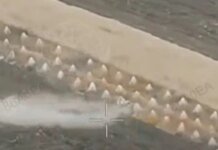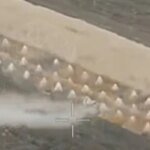Save StorySave this storySave StorySave this story
After four years of construction, Intel said on Thursday that its Fab 52 semiconductor plant in Chandler, Arizona is now turning out its first chips. The company also shared more details about the long-awaited CPUs that it will be producing in the facility using Intel’s brand new 18A process technology.
The announcement comes just six weeks after the Trump administration acquired a 9.9 percent stake in Intel in exchange for $8.9 billion in stock. The fab opening, while long in the works, is the first major opportunity for the struggling American chip maker to convince the broader tech industry that it can produce some of the world’s most advanced chips at scale—and that the White House’s investment might pay off.
Late last month, Intel invited dozens of analysts and business partners, along with a handful of journalists, to tour Fab 52. The tour offered an extremely rare glimpse into the world of modern chipmaking, where robots perform most tasks, lithography machines the size of school buses print microscopic patterns on silicon wafers, and workers shuffle around in anti-contamination “bunny suits,” booties, goggles, and gloves. (Guests are required to wear the suits, too.) Intel says that the air within the fab is recycled every six seconds.
All of this is to prevent contamination of the fragile silicon wafers that the entire computing industry runs on. If a single speck of anything lands on a wafer, it can be irreparably damaged.
Make or Break
Intel says that its Fab 52 has technically been operational since July, and the new generation of chips being made there, dubbed Panther Lake and Clearwater Forest, have been in the works for years at this point.
But Intel decided to show off its new fab at a critical moment for the company. The facility is designed to make chips using a new process, called 18A, that’s supposed to yield more powerful and efficient products. “Supposed to” is key: Intel’s near-term fate hangs on whether it can produce semiconductors that are impressive enough to not only serve its usual hardware and computer customers, but also attract AI companies with large sums of cash to spend on advanced chips and data centers.
During the tour, Intel executives emphasized that Fab 52 is the most advanced chip manufacturing plant in the world. That may technically be true—the company's fabs, or foundries, “have been long known and respected in the industry for making the next node possible,” says Austin Lyons, an analyst at Creative Strategies and founder of Chipstrat, a semiconductor publication. In the early 2010s, for example, Intel made another significant node, or process advancement, when it introduced 32-nanometer chip technology. (Its latest chips are 2-nanometer.)
“But while Intel is good at figuring out how the industry can build the next-gen technology in a way that can be manufactured, TSMC is good at that and then saying, ‘How can we do this at high volume, high yield?’” Lyons said, referring to Taiwan Semiconductor Manufacturing Company, widely considered the most advanced global chip firm.
Intel first pioneered the chips that revolutionized computing (and defined “Silicon Valley”) in the 1970s. The company started to falter in the mid-2000’s when it failed to capitalize on the mobile phone boom and lost ground to emerging competitors. By that point, the US semiconductor industry had already moved a significant amount of manufacturing overseas to places like Taiwan.
Over the past few years, the rise of generative AI has led to a spike in demand for high-performance computing chips from Intel competitors Nvidia and AMD, putting the company at an even bigger disadvantage. Since 2024, the chipmaker has laid off tens of thousands of employees. In July, Intel’s market capitalization was less than $100 billion dollars, while Nvidia’s was roughly $4 trillion.
On the heels of the Trump administration’s unorthodox bailout, Nvidia also made a $5 billion strategic investment in Intel. The not-so-subtle message: Intel must be saved, but it has proven it can’t save itself.
Inside the Fab
Fab 52 is located on a patch of flat desert land approximately 20 miles outside of Phoenix, Arizona. It’s part of a sprawling complex that also includes Fab 42, which began operating in 2020, and Fab 62, which is still under construction. The entire thing spans one million square feet.
The concrete and steel buildings stand in contrast to the green irrigated fields beside them, land that belongs to the Gila River Indian Community. Intel has assigned cutesy names to the roadways that wind around the facilities, like Data Drive, Transistor Terrace, and Silicon Street—but aside from that and the sheer size of the place, the exterior doesn't betray much of what goes on inside. At the time of the tour, a sign for “Construction Suicide Prevention Week” was affixed to a metal fence. A gigantic American flag hangs from an overpass at the entrance.
Everyone who enters the fabs has to wear a bunny suit, and get dressed—or be dressed—in a clean room. Makeup, hair products, perfumes, colognes, and any aerosol products are prohibited. Workers are separated by a metallurgical hierarchy: There are those who work with copper, and those who do not. The copper people wear orange suits, not white, and have to suit up and strip down in their own clean room.
The Intel fab worker who helped me suit up proudly told me that he has done the same for two US presidents: Obama, who visited Fab 42, and Biden, who visited Fab 52 while it was under construction. As of late September, Trump still hadn’t visited, though Intel spokesperson Cory Pforzheimer said, “We’d eagerly welcome President Trump to see the most advanced R&D and leading-edge semiconductor manufacturing in the US.”
The workers shuffling around are not pulling levers and grinding away at the gears of manufacturing as much as quietly managing robots. They stand at (sterilized) computer stations while containers called front-opening unified pods, or FOUPs, whoosh by overhead through a labyrinth of robotic tracks. The rows of equipment appear endless. The floor below has been reinforced, then reinforced again, because the tiniest of shakes can ruin a whole batch of chips.
The lithography section of the facility is awash in a strange glow, which turned our white suits neon green and the copper-suited people pink. Intel demanded that the fab tourists not share the names of its suppliers, with the exception of one: ASML, the Dutch manufacturer of the world’s most cutting-edge lithography machines. WIRED witnessed two massive ASML Twinscan machines that appeared to be operational. The floor next to them was tape-marked with space for two more.
Intel has not yet publicly said how many semiconductors it expects to successfully yield, or manufacture, at Fab 52 annually. For now, the chips produced there will be used in consumer devices like laptops. But what Intel really needs is the same thing the entire industry is chasing: A hyperscaler customer, a giant data center deal, someone looking to spend billions to get an edge in AI. A whale.
Design Overhaul
Intel’s Panther Lake and Clearwater Forest chips will be made using a manufacturing process that tosses aside decades of proven design techniques in favor of two new technologies the company calls RibbonFET and PowerVia. RibbonFet is an architecture for transistors, stacking them in a way that allows for more density, while PowerVia moves the power interconnects from above the silicon stacks in the chip to below them.
Intel began working on the new design approach in 2021, and early tests have shown that RibbonFet and PowerVia led to performance gains. Reports suggest these new chips also use 30 percent less energy than the prior generation.
“Credit where credit is due, Intel is introducing both of these—RibbonFET and backside power—before TSMC, so they are the ones taking the risk here,” says Lyons. “I hope that bet pays off for them.” Competitors like Samsung and TSMC are now planning to introduce technologies similar to RibbonFet and PowerVia in their 2-nanometer chips.
But the overall performance and reliability of the new chips won’t be clear until they are shipped to customers at scale. Panther Lake, which is Intel’s third series of premium CPUs with dedicated AI processors, will start shipping this quarter. Clearwater Forest, which is designed for servers in data centers, arrives in the first half of 2026.
As Intel ramps up Fab 52 and its cutting-edge 18A process, the company will remain under intense public scrutiny. Customers are watching for any advantage they can use to get ahead in the AI arms race, hoping Intel’s new capacity will give them a performance edge. The Trump administration is eager to champion American manufacturing, but remains a vocal and unpredictable partner.
Wall Street is focused on whether Intel can leverage these advances to lift chip prices, expand margins, and regain momentum in an increasingly competitive market. Analysts and amateur chip nerds, meanwhile, are dissecting Intel’s supply, demand, and capacity to manage risk. And everyone is still questioning whether the chipmaker, once a crown jewel of the American tech sector, has enough momentum to make a real comeback.
































